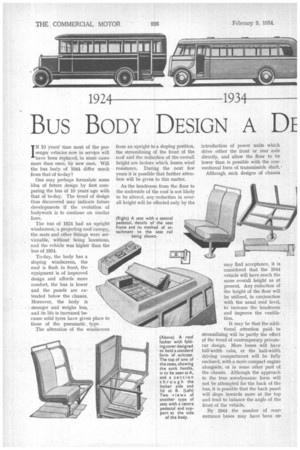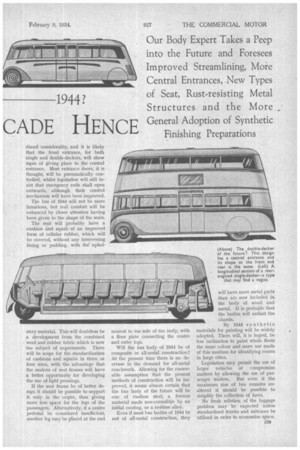BUS BODY DESIGN A DE CADE HENCE
Page 86

Page 87

If you've noticed an error in this article please click here to report it so we can fix it.
/ N 10 years' time most of the pas senger vehicles now in service will have been replaced, in soin cases more than once, by new ones. Will the bus body of 1.044 differ much from that of to-day?
One may perhaps formulate some idea of future design by first comparing the bus of 10 years ago with that of to-day. The trend of design thus discovered may indicate future developments if the evolution of bodywork is to continue on similar lines.
The bus of 1924 had an upright windscreen,' a projecting roof canopy, the seats and other fittings were serviceable, without being luxurious, and the vehicle was higher than the bus of 1934.
To-day, the body has a sloping windscreen, the roof is flush in front, the equipment is of improved design and affords more comfort, the bus is lower and the panels are extended below the chassis. Moreover, the body is stronger and weighs less, and its life is increased because solid tyres have given place to those of the pneumatic type.
The alteration of the windscreen from an upright to a sloping position, the streamlining of the front of the roof and the reduction of the overall height are factors which lessen wind resistance. During the next few years it is possible that further attention will be given to this matter.
As the headroom from the floor to the underside of the roof is not likely to be altered, any reduction in overall height will be effected only by the introduction of power units which drive either the front or rear axle directly, and allow the floor to be lower than is possible with the conventional form of transmissio'n shaft.
Although such designs of chassis may find acceptance, it is considered that the 1944 vehicle will have much the same overall height as at present. Any reduction of the height of the floor will be utilized, in conjunction with the usual roof level, to increase the headroom and improve the ventilation.
It may be that the additional attention paid. to streamlining will be partly the effect of the trend of contemporary privatecar design. More buses will have full-width cabs, or the half-width driving compartment will be fully enclosed, with a more compact engine alongside, or in some other part of the chassis. Although the approach to the true aerodynamic form will not be attempted for the back of the bus, it is possible that the back panel will slope inwards more at the top and tend to balance the angle of the front of the vehicle.
By 1944 the number of rearentrance buses may have been re duced considerably, and it is likely that the front entrance, for both single and double-deckers, will show signs of giving place to the central entrance. Most entrance doors, it is thought, will be pneumatically controlled, whilst legislation will still insist that emergency exits shall open outwards, although their control mechanism will have been improved.
The bus of. 1944 will not be more luxurious, but real comfort will be enhanced by closer attention having been given to the shape of the seats.
The seat will probably have a cushion and squab of an improved form of cellular rubber, which will be covered, without any intervening lining or padding, with the' uphol
stery material. This will doubtless be a development from the combined wool and rubber fabric which is now the subject of experiments. There will be scope for the standardization of cushions and squabs in three or four sizes, with the advantage that the makers of seat frames will have a better opportunity for developing the use of light pressings.
If the seat frame be of better design it should be possible to support it only in the ceutre, thus giving more free space for the legs of the passengers. Alternatively, if a centre pedestal be considered insufficient, another leg may be placed at the end
nearest to the side of the body, with a floor plate connecting the centre and outer legs.
Will the bus body of 1944 be of composite or all-metal construction? At the present time there is no decrease in the demand for all-metal coachwork. Allowing for the reasonable assumption that the present methods of construction will be improved, it seems almost certain that the bus body of the future will be one of rustless steel, a ferrous material made non-corrodible by an initial coating, or a restless alloy.
Even if most bus bodies of 1944 be not of all-metal construction, they will have more metal parts than are now included in the body of wood and metal. It is probable that the bodies will outlast the chassis.
By 1944 synthetic materials for painting will be widely adopted. There will, it is hoped, be less inclination to paint whole fleets the same colour and more use made of this medium for identifying routes in large cities.
Legislation may permit the use of larger vehicles or compromise matters by allowing the use of passenger trailers. But even if the maximum size of bus remains unaltered it should be possible to simplify the collection of fares.
No fresh solution of the luggage problem may be expected unless standardized trunks and suitcases be utilized in order to economize space.




































































































































































